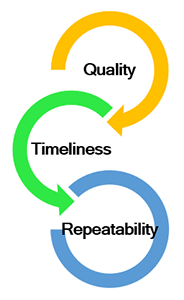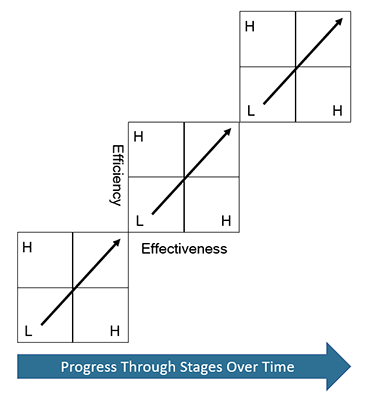by Dr. Dale J. Albrecht
© 2022, Alonos® Corporation
Executive Summary
This white paper Provides a broader view of organizational effectiveness by expanding the time horizon. Effectiveness and efficiency at one point in time does not equate to the same performance at a future point in time. When organizations are left alone to evolve organically, departments and teams eventually end up being an impediment to overall firm growth.
You’ve heard the saying “time heals all wounds.” That saying is mostly true when it comes to healing the human body. Over time, a physical wound will heal itself…mostly. Over time, an emotional wound will heal…mostly. But, when it comes to organizational health, the opposite is true. When organizations are left to simply evolve on their own, time wounds most organizations.
Organizational Effectiveness?
The first item of note, in for-profit firms, is delivering economic market value. A firm exists in order to deliver goods and services that customers will purchase, and it is a firm’s aim to position themselves in the market so that a customer will choose to buy from them versus a competitor or another substitute for the good/service. Organizational efficiency is a firm’s ability to deliver products and/or services to the market place using the least amount of raw material and resources in order to convert it for consumption. Organizational effectiveness is a firm’s ability to deliver products/services with quality, timeliness, and repeatability.

Time Needs to be Managed
It’s important to recognize that organizational effectiveness is a longitudinal concept. Time plays a very large role in sustaining OE. Let’s assume an organization is both optimally-effective and optimally-efficient today. Over the next 5 years the organization is successful and grows at a 8% compounded annual growth rate. Eight percent per year seems manageable, right? At that rate of growth, a $500m company turns into a $735m company. At the end of a 5-year cycle, the company has experienced a compounded growth of 47%!

Successful Scaling Over Time
Departments and functions that process volume-based transactions tend to scale-up in a more successful manner. For example, in the accounting department of a company, that experienced a similar growth rate as mentioned, invoice processing, billing/receivables, and payables grew over a 5-year time period. The changes in accounting were volume-based in terms of the number of transactions. The department added personnel and software licenses that allowed them to complete the higher volume of transactions. Resources were added to the billing, accounts payables, and accounts receivables departments. There was no need for fundamental changes in the accounting department.
Unsuccessful Scaling Over Time
There are departments and functions that require a change in capabilities, and they can get missed along the way. They quickly find themselves no longer effective or efficient at their work. What was high efficiency/effectiveness at one growth stage becomes low efficiency/effectiveness at the next. Capabilities, departments, and functions that are left to “evolve” over time often find themselves struggling to deliver the outputs needed to enable the business to grow further. Eventually, any department like this may become a limiting factor for the firm.
Take as an example the same company. From its inception through the $500m point, human resources (HR) reported to the CFO. This is fairly common in small companies, as the nature of the work in HR is highly transactional at the early stages of a business’ lifecycle. The HR work consists of hiring, employee records, payroll, and administration. As this particular company grew from $500m to $800m their needs changed dramatically. The growth caused the company to expand their operating units so that they could provide additional services to the market-place. Where they had only delivered through one operating unit in the past, they now expanded to seven operating units, each with their own sources of revenue. They needed to expand in this way because the market was shifting toward providers that could offer a broader set of services versus specialists (specialists were becoming sub-contractors.)
The impact of the business changes meant that the company now needed many more capabilities from HR. Benefits administration needed to evolve to include third party management of a brokerage along with benefit plan designs, which took the company away from a fully insured plan toward a partially self-insured plan. A full compensation function needed to be developed which addressed pay-for-performance, planned merit cycles, and strategically aligned incentive plans. In addition, local and state contracts required sophistication in compensation analyses, design, and compliance. The company’s hiring methods needed to change dramatically as well. The employee base grew from 450 to 1,200 in the same period of time, and the labor market became more competitive. No longer were referrals and signage enough to bring in the talent that the company needed. They also needed a web/social media presence, an applicant tracking system, and a formal on-boarding process that varied by type of role. The CFO, while highly astute at accounting and finance, was not the HR leader that the company now needed. What was an effective and efficient human resources department was now an ineffective and inefficient function that was impeding the company’s growth.

Solution: A Longitudinal Approach
Needed changes like the one described above un-folded over and over throughout this particular company. They are not unique though; their experience is common for those functions that go through a capability change. These include departments such as human resources, information technology, supply chain, marketing, sales, and engineering. Where functional departments have been left to evolve on their own, those departments can end up being wounded by time, to a point where they become an impediment to the firm’s progress.

Improving Performance
From the c-suite it is difficult to get a sufficient review of the status of all the functions. A company that invests in OE ensures that regular health-checks are being performed so that every department can be intentionally designed to meet the ever-changing needs of the business. An installed OE process is a critical enabler to the c-suite and the board in order to ensure continued growth in performance and lock-step improvement in organizational capabilities. Boards should use an expert consulting firm that partners with the firm to set up a board-level OE committee, internal OE function, and a governance process that ensures checks/balances and promotes organizational health.
Recommended Citation:
Albrecht, D.J. (2018). Designing Organizations: Why Time Wounds All Organizations (White Paper). Dallas, TX: Alonos Corporation. Retrieved from: alonos.com/resources
For further reading on this subject, pick up Dr. Albrecht’s book:
You can order it through major booksellers

